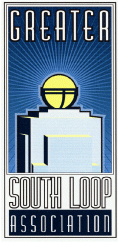|

 GSLA Committees GSLA Committees
 GSLA Board GSLA Board
 GSLA By-Laws GSLA By-Laws
|
The South Loop Heritage
The Early Residents
In the 1870’s, the city’s elite built imposing mansions along Prairie Avenue on the Near South Side. The original Marshall Field was a South Sider, as were George M. Pullman of Pullman railcars and Philip D. Armour of the meatpacking empire. By the early 1900s, 40 of the 60 members of the exclusive Commercial Club lived in a five-block area along Prairie and adjoining Calumet Avenue. A small community of affluent blacks lived nearby.
The rich whites began to leave in the 1920’s, when rooming houses sprouted to accommodate waves of European immigrants. Before long, nearly every residence had been carved up into tiny flats. And then carved up again in the 1940’s, when the great influx of southern blacks who moved to Chicago to work in the factories and steel mills and stockyards were barred from living in other parts of the city. By the end of World War II, much of the near south side was dilapidated tenements.
People had started to move into the downtown area during the 1960’s, but they were concentrated on the Loop’s northeast fringe – along the river and near the lakefront. The only residents of the South Loop lived in tiny cubicles in the flop-houses and cheap hotels near those empty railroad tracks. Some of them, in fact, lived on the empty railroad tracks.
In the blocks close to the rail yards, rough bars and sleazy hotels were about the only flourishing businesses. Under the elevated transit tracks a block south of the Board of Trade, muggings and purse snatching and assorted assaults were on the rise. They weren’t nearly as commonplace as the rumors about them, but the impact was the same. People were afraid of the South Loop. Some people thought Sears was crazy to put its new tower, and 5000 employees, in the South Loop.
The railroads and printing industry
Throughout the late 1800s, one new railroad line after another steamed into the rapidly growing city. Businessmen didn’t want them to disrupt their newly rebuilt downtown, so the depots lined up on the outskirts. Four were built on the Loop’s south edge within less than a mile of each other: Dearborn Station in 1885, Grand Central in 1890, Central Station east of Michigan Avenue in 1893, and LaSalle in 1903. The cluster of stations brought thousands of jobs to the area, but as historians Perry R. Duis and Glen E. Holt wrote in Chicago Magazine, the heavy passenger traffic also “attracted houses of prostitution, gambling rooms and saloons. Of all Chicago’s vice districts, the largest was… at the front door of the terminals and within walking distance of the major hotels. “
What bothered the city’s business leaders more than vice being flaunted in their faces was that the rail yards blocked expansion of the Loop to the south. In 1913 the City Council recommended consolidation of the stations, the first of about 30 such plans offered by government and civic groups over the next 50 years.
By the late 1960’s, the plunge in passenger rail travel and the growth of transcontinental trucking accomplished what decades of civic efforts could not. In 1969, Grand Central and LaSalle stations closed. By 1970, Dearborn and Central stations were winding down, with only months to go.
The decline of the rail industry hurt the businesses that had grown up around it. In the South Loop, the chief casualty was the printing industry concentrated around Dearborn Station. The location had been ideal; paper and other supplies arrived through the terminal, and finished publications left from it. Skilled German, Italian, and Polish immigrants got off the trains from New York and walked a few steps up Dearborn Street into jobs as type-setters, engravers, mapmakers, and bookbinders. As the industry thrived, owners commissioned new buildings from the talented architects who had settled in Chicago to help rebuild it after the 1871 fire. The district became a showcase for a city already famous for its architecture.
The collapse of the rail industry during the 1950s and 1960s coincided with the introduction of technologies that made the printing establishments obsolete. They moved to new plants elsewhere, and the great Dearborn Street buildings emptied out. So, in addition to the vast stretches of abandoned rail yards and the porn-and-sleaze strip slithering toward the financial district, the South Loop by 1970 was burdened with blocks of vacant and vandalized buildings.
The Turnaround
Around 1976 some local businessmen and developers decided it was time to do something with the vast area around the railyards. They conceived of a brand new neighborhood called Dearborn Park. It would be completely new construction with 2 residential towers as well as mid-rises and townhomes. After years of planning and development, Dearborn Park opened in 1980. By 1981 it had about 1000 residents. Not long after Dearborn Park began development, another group of men saw potential in the area of abandoned buildings north of Dearborn Station. The first building to get transformed was the Transportation building. It was built in 1911 to house many small companies involved in the railroad industry, but it had been sitting empty for years. In 1981 a complete overhaul of the building was completed and it became rental apartments. Also bought was the Donohue building, built in 1883 to accommodate publishing and bookbinding firms. In 1978 it became Chicago’s first residential loft building. More and more of the old Printers Row buildings were bought and converted to residential and retail spaces. The last of the vacant buildings, the Peterson, was converted in 1995 and quickly sold out.
The two neighborhoods, one rising fresh and new from rubble and railroad tracks, and the other carved into the city’s precious architectural heritage, were made for each other.
|